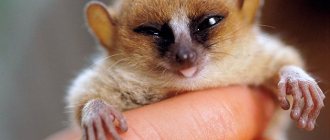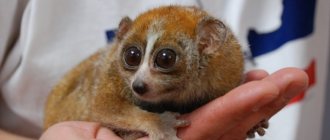A lemur is a mammal of the order Primates, suborder Wet-nosed monkeys, infraorder Lemur-like, family Lemuridae.
About 50 million years ago, at the dawn of the Cenozoic era, the first primates appeared on planet Earth. Over time, they divided into 2 groups - monkeys and prosimians. About 25 million years ago, prosimians gave rise to a group of lemurs. In those distant times, lemurs flourished, but were later driven out from everywhere by real monkeys. But there is still a place on Earth where these ancient and mysterious creatures are preserved. The magical island of Madagascar, which is often called the “Island of Lemurs,” has become the habitat of these unique representatives of the fauna.
The word “lemur” itself means “spirit of the deceased” or “ghost”. These animals with saucer-like eyes were considered ghosts because many of them are nocturnal, disturbing the silence of the tropical forest with their sometimes piercing, sometimes mournful cries. And according to local belief, the dead, or those who left people and went to live in the jungle, move into lemurs. In fact, lemurs are charming and harmless creatures.
Lemurs have thick hair of various colors, a fluffy and long tail, an often elongated muzzle, and large, close-set eyes. The limbs are grasping with well opposable thumbs. Nails grow on all fingers, only on the lower extremities one finger has a long claw, which is used by animals for hygienic purposes - with its help they care for their fur and clean their ears..
No one can say for sure how many different species and subspecies of lemurs live on the island. Every year, scientists describe more and more new species. If at the end of the 20th century 31 species were classified as lemur-like, today more than a hundred species of lemurs are known, grouped into five families.
Different species of these animals can differ significantly both in appearance and size, and in their lifestyle. So, if the dwarf mouse lemur weighs no more than 50 grams, then Indri’s weight can reach 10 kilograms.
Nature designed it in such a way that the habitats of all types of lemurs on the island are scattered in spots. Each species has characteristics of behavior, habitat and rhythm of life. Some species hang on trees all day long and slowly consume greenery, while others spend more time on the ground hunting insects and small vertebrates. Among these animals there are both diurnal and nocturnal species. Daytime ones are usually larger and brighter in color; they love to soak up the sun, lying on the branches of trees. Night wanderers awaken at dusk, filling the forest with screams, start a “marathon” and go in search of food, often covering vast distances. They are even brighter-eyed than their diurnal relatives.
Even the principles of building a lemur family differ from species to species. Some are monogamous, others prefer polygamous harem families, and still others change partners every year.
All lemurs are extremely interesting, amazing and charming. Let's talk about some types in more detail.
Indri - the “giant” among lemurs
They say that once upon a time there lived huge lemurs in Madagascar, whose weight reached 200 kilograms! Today, the largest lemur is recognized as the short-tailed Indri (Indri indri), which lives in the northeastern regions of the island. The body length of a babakoto (as the local population calls indri) can reach 90 cm; The indri's tail, compared to other species, is short - about 5 cm. The animal's muzzle is elongated and slightly resembles a dog's, the ears are large and shaggy, and the lips are red. The fur all over the body is very thick with a white-gray-black pattern, and the muzzle is almost hairless.
Lemur Vary - a plush miracle
Lemur variegata
Lemur variegata (Varecia variegata) is another large representative of the family. These beauties live in the rain forests of the eastern part of the island and feed mainly on fruits. They prefer to live in groups of up to 30 individuals. Matriarchy reigns among the Vars, i.e. females dominate here.
Look at the photo: the lemur's body resembles a plush toy, and its fingers are just like human ones!
And in this species, females also dominate - the leader of a group of 15-20 animals is the largest of the adults.
Reproduction and lifespan
Reproduction in these unusual animals has its own characteristics. Let's look at the breeding process of ring-tailed lemurs. As a rule, females give birth to one baby during one breeding season, but in some cases two babies are born at once.
The female's pregnancy lasts 222 days; babies are born during the rainy season, this time from August to September. The babies weigh approximately 100 grams. From the first moments of life, babies are very tenacious; they hang on their mother’s fur, and this is how they spend the first months of their lives.
First, the baby hangs on the mother’s stomach, and then moves onto her back. After about 1.5-2 months, the lemur cub begins to leave its mother and make its first independent forays.
But he cannot get by on his own, so he is with his mother during sleep and feeding. Only at the age of 6 months do baby lemurs become independent and no longer need the care of an adult.
The lifespan of a lemur is approximately 35-37 years; as a rule, in an artificially created environment they can live longer if they are provided with proper care and nutrition.
Bamboo lemur - a charming “gourmet”
There are three species of bamboo lemurs known to science: the golden lemur (Hapalemur aureus), the broad-nosed lemur (great bamboo lemur) (Prolemur simus) and the gray bamboo lemur (Hapalemur griseus).
It is not for nothing that the animals received such a name, because they cannot imagine their life without succulent bamboo, and each species prefers certain varieties. Between 90 and 98% of their diet comes from bamboo shoots, stems, seeds and fruits. It is noteworthy that bamboo shoots contain cyanide in high concentrations; for most mammals these substances are fatal, but not for the lemur - he spends almost all his time in the bamboo thickets and puts fresh leaves in his mouth, being distracted only to sleep.
The golden bamboo lemur is the rarest species. It is the size of a cat and weighs 1-1.5 kg.
Golden bamboo lemur
In the photo below, the great bamboo lemur is one of the largest species, found in the southeast of Madagascar.
Great bamboo lemur
Undoubtedly, all lemurs are charming creatures, but perhaps the cutest are gray bamboo lemurs. These little elves are found in the east and north of the island.
Gray bamboo lemur
Option 2
Among primates there are species that differ from the order. One of these is the lemur. It is unique in its prevalence. But more on this a little later.
Basic data
It is impossible to say exact figures about the weight and size of these creatures, since the difference between the species themselves is very significant. Some can be small and light, while others can be large and weigh up to 10 kg. Lemurs, in principle, are not large animals. Now about their habitat. They live exclusively on the island of Madagascar. Thanks to the fact that higher primates did not reach this island, lemurs are still alive.
Since 2008, 93 species of lemurs have been known. All species are divided into 6 families. They live most of their lives in trees. Nocturnal lifestyle predominates. Communication occurs through sounds similar to either grunting or purring. In general, lemurs are herbivores. Their diet includes tree leaves, fruits, tree bark and flowers. They can eat insect larvae. In general, lemurs live for about 20 years.
Enemies of lemurs
Lemurs are common prey for predators. For example, owls, hawks, snakes and civets. Fossa also hunt lemurs.
Domestication of lemurs
You can easily turn a wild lemur into a domestic one by observing the right conditions. You need to know how to feed lemurs and how to raise them properly. The cage must have branches or artificial wood so that the primate can climb there. It is mandatory to fill the bottom of the cage with sawdust. This is done for the reasons that there is no way to accustom the lemur to the tray. Therefore, this same house will have to be cleaned regularly from time to time. His cage must have a tray with water.
Lemurs do not tolerate drafts, so you will have to close the windows or choose the location carefully. It must be recalled that the lemur is a nocturnal animal. Therefore, you don’t have to worry about the fact that he doesn’t eat anything. Moreover, you should not force him to eat. You can feed domesticated lemurs with many things: bread, cereals, boiled potatoes, carrots, various fruits, dried fruits, and so on.
Amazing facts about lemurs
• Lemurs can offer hygiene services to each other.
• The population of Madagascar is afraid of lemurs. People think that if they kill a lemur, they will be cursed and die within a year.
• These primates are the least similar to humans.
• Hungry lemurs can even eat rotten wood.
Catta is the most popular lemur
Perhaps the most famous and “promoted” lemur by popular culture is the catta lemur (Lemur catta) or ring-tailed lemur. The local population calls it "maki".
Its distinctive feature is a luxurious tail with black and white rings. By the way, another name for this lemur is “ring-tailed.” It lives in dry woodlands in the south of Madagascar. Catta is the size of a cat, but truly beautiful. The bright white muzzle is decorated with large golden eyes framed by black glasses. The belly, chest, neck and ears are completely white, the fur on the back is gray or pinkish-brown. It is noteworthy that the entire skin of the body is black.
This lemur is called a cat lemur not only because of its long and fluffy tail. The sounds that the catta makes resemble meowing and purring. But this is in a calm state. When the animal is excited or frightened, it squeals loudly and shrilly.
Keeping lemurs in captivity
These funny animals must be kept exclusively in a cage or enclosure. An apartment in the city is unlikely to be suitable for this. Despite the fact that lemurs are not prone to mischief, if you leave them alone, they can accidentally break something. Also keep in mind that lemurs are difficult to train, they are a wild animal and it is impossible, for example, to toilet train them - like, for example, cats, so if you keep them freely, you will constantly find your lemur’s excrement in the most inappropriate places. They should not be forced or scolded; the animal may become angry.
The cage or enclosure should be spacious enough for your pet to climb and exercise. Indeed, despite the apparent slowness, these animals are quite active. In your pet's home, you need to build a nest in the form of a wooden house or a fur hat - suitable for small species, where he will feel safe and can rest peacefully. It is advisable to put hay or cotton wool in the nest to make your pet comfortable. Also place tree branches and various crossbars in the cage or enclosure so that the lemur has somewhere to climb.
It is worth buying a lemur in infancy, since an adult animal will take a long time to get used to, and the percentage is small that it will like living in a new environment. It is worth adopting a lemur from breeders, since the animal is wild and is considered a carrier of a number of diseases. Therefore, take your pet with a medical card and vaccinations. Whom to take, a boy or a girl, is an individual question. It is believed that females are the best to train. If you want to start breeding, then it is better to buy them at a young age so that they can get used to each other. Before buying, you should make sure of your financial capabilities; keeping a lemur is not a cheap pleasure; it costs about 100 thousand rubles.
It is necessary to locate the lemur's home in a calm and quiet place away from drafts and heaters. In order to maintain hygiene and prevent unpleasant odors, it is recommended to clean the cage or enclosure regularly. Once a month, it is advisable to do a general cleaning, wiping your pet’s home with a damp cloth and replacing its bedding with a new one. Also keep in mind that there should always be a drinking bowl with clean water in the lemur's cage.
As for nutrition, it is quite varied and includes food of both plant and animal origin. Your pet's diet must include insects, dairy products, cereals, as well as fresh fruits and vegetables. With particular pleasure, lemurs eat mealworms, fruits, bread soaked in water, boiled eggs, rice and millet porridge. If your animal is picky and refuses this or that food, then you can smear it with honey. Be sure that the animal will not refuse such a treat!
Little hand - the most unusual lemur
The little hand, also known as the Madagascar little hand, also known as the aye-aye (Daubentonia madagascariensis) is a truly alien creature. Outwardly, the aye-aye is completely different from its fellow lemurs. There was a time when, due to the peculiar structure of the teeth, the baton was even classified as a tropical rodent. Scientists argued for a long time about what species this unusual animal should be classified as, but in the end they came to the conclusion that it was not a rodent at all, but a special type of lemur, only slightly deviated in development from the general trunk of the group.
The slender body, approximately 40 cm long, is covered with hard, straight dark brown or black hair, the tail reaches 60 cm. The muzzle is short, compared to other species, and is decorated with orange-yellow or greenish eyes and huge leathery ears.
Madagascar bats live in the dry forests of the western part of the island. Seeing this lemur in person is not so easy; the animal is nocturnal and comes to the ground only occasionally.
Nutrition
Different species of lemurs have different food preferences. Some of them feed exclusively on vegetation, while some also include an animal component in their diet. Lemurs mainly feed on fruits, various fruits; in addition, they eat leaves, flowers, young shoots of plants, and can also feast on cacti.
Some members of the lemur family add insects to their food, which are usually a source of protein. The main thing is that the diet is well balanced, then the lemur fully develops and grows healthy, leading an active lifestyle.
Sifaka - the most jumping lemur
Verreaux's sifaka or crested indri (Propithecus verreauxi) lives in the northern part of the island. It is also called the dancing lemur, because it moves along the ground by jumping on its hind legs, with its arms spread wide. From the outside it seems as if he is performing some kind of funny dance. In general, sifakas are absolute champions in jumping and flying. They can easily jump onto the second floor of a residential building!
Sifaka is popularly called a sun worshiper. When the sun rises, he sits on a tree branch, raises his hands and freezes. It seems as if the animal is praying to its gods. In fact, lemurs bask in the sun specifically to warm their wrists. In this place there are glands that secrete a special lubricant. Hanging on a tree, the animal leaves its scent on the bark, which makes it clear to strangers whose territory it is.
The tiniest lemur
The dwarf mouse lemur (Microcebus myoxinus) is the smallest of the genus of mouse lemurs (you can read more about miniature lemurs here). It lives in dry forests in the west of the island. The weight of the lemur does not exceed 40 grams. Look at the photo, the lemur fits comfortably in the palm of your hand, while the baby’s tail is larger than itself!
Sadly, there are very few lemurs left on our planet. Today, almost all known species have become rare and are listed in the Red Book. And man became the reason for the disappearance of these charming creatures. And if lemurs can hide in the foliage from their natural enemies in nature - hawks, then there is no escape from a person who exterminates animals for commercial purposes, and also cuts down forests and bamboo groves, depriving the animals of their natural habitat. If this continues, then the only place where these amazing defenseless animals can find shelter will be zoos.
- Slender-bodied lemurs
- Ring-tailed lemur:...
- Dwarf and...
- Little hand (ah-ah)…
- Lemur indri
- Mirikins are nocturnal...











